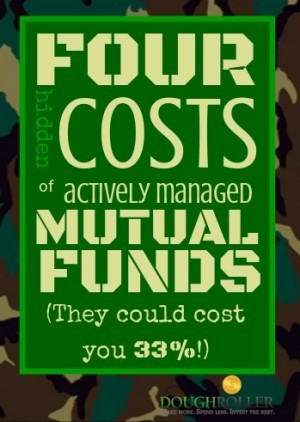Mutual Funds Hidden Costs
Post on: 29 Июль, 2015 No Comment

This article was last updated October 31, 2005.
Most investors are familiar with the expense ratio that a mutual fund manager takes from shareholders each year as compensation for running the fund, but they may be unaware of other hidden costs that may take even more from an investor’s pocket. Brokerage commissions paid by the fund, the bid/asked spread on every trade, and market impact costs that are incurred by fund managers as they try to buy (or sell) a large position in a short period of time often dwarf the reported expense ratio of the fund.
1) Expense Ratio.
The expense ratio includes the fund manager’s salary, office overhead, bookkeeping and accounting costs, legal fees, hiring outside consultants or advisors, preparing and mailing monthly statements, etc. Annual expense ratios can be as low as a few basis points (1 basis point equals 1/100th of a percent or 0.01% of assets) for a large institutional index fund to over 300 basis points for the most expensive of the actively managed mutual funds. The average expense ratio for the 14,000 mutual funds available to the public is 140 basis points. Index funds available to the public such as Vanguard’s Index 500 Admirial Shares have expense ratios as low as 10 basis points.
2) Brokerage Commissions.
The average US domestic mutual fund pays about 5 cents in brokerage commissions for every share of stock bought or sold in the fund. Vanguard averages about 2 cents per share in its low-cost index funds.
On a percent of assets basis brokerage commissions average about 0.3 basis points ($3 per $100,000 invested) for the Vanguard 500 Index Fund, 1 basis point for the Vanguard Small Cap Value Index Fund and 3.4 basis points for Fidelity’s Magellan Fund. Forbes magazine recently listed the Dirty Dozen mutual funds with the largest percentage of assets lost to brokerage commissions. It wasn’t pretty. The Dreyfus Founders Passport Fund — A paid an astonishing 464 basis points in brokerage commissions in 2004.
3) Bid/Asked Spread
The most common measures of the bid/asked spread are quoted spread and effective spread.
The quoted spread is simply the difference between the quoted bid and ask prices (i.e, the difference between highest price a buyer is willing to pay and the lowest price at which seller is willing to sell.) Large cap stocks like ExxonMobil and General Electric, trade millions of shares each day, thus the bid/asked spread is usually small — often just a few pennies. On the other hand, a small cap stock might only trade a few thousand shares daily. These stocks generally have much wider bid/asked spreads.
The effective spread is two times the difference in the price at which the trade is executed and the midpoint between the quoted bid and ask spread at the time the trade is executed. This method estimates that the “true” value of the security is mid-point between the prices at which you can buy (ask) and sell (bid) the stock. If you indeed purchase at the ask price or sell at the bid price, then this method of measuring implicit costs is the same as the quoted spread. However, many purchases and sales of stocks occur at prices that are better than the quoted bid or ask price. The effective spread takes into account this “price improvement” that may occur on orders. Multiplying by two simply transforms the spread into an estimate of “roundtrip” implicit costs. (Karceski, Livingston, et al, Nov. 2004.)
Effective Spreads














